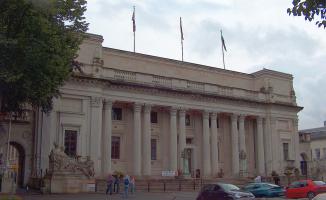
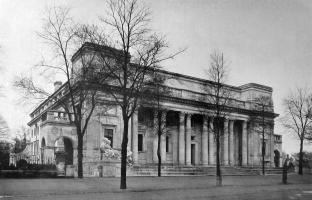
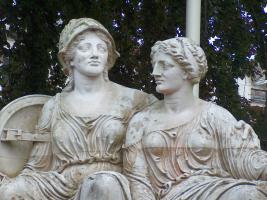
Glamorgan County Hall, now and when it was built.
Glamorgan County Hall, now and when it was built.


Among the grandest sculpture in Cardiff are the two groups by Albert Hodge in front of Glamorgan County Hall. They represent Navigation and Mining, and of gargantuan scale.
Albert Hodge's sculptural group 'Mining'.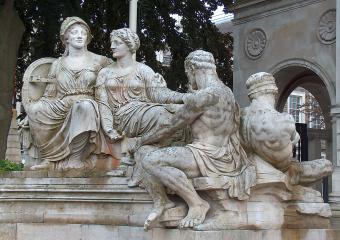
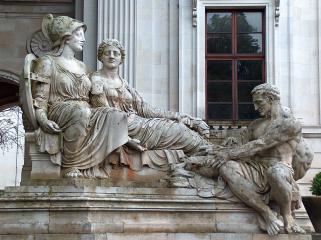
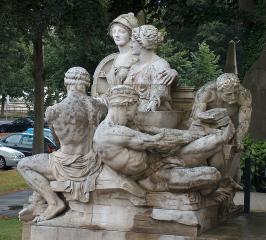
Mining first. There are five figures in all, two allegorical females, and three miners, the composition being such that from the front, only four of the figures are seen, and you need to walk right round the group to be able to see them all and see their faces. Albert Hodge is known for his emphasis of muscularity, and the two female statues show this in the thickness of their necks, the heavy hands and feet, and the sheer mass and solidity of their bodies. They are seated, one forward-facing and upright, the other somewhat reclining against her. The uppermost figure is an Athena, with the Corinthian helmet of the Ancient Greeks pushed up and backwards to expose her full face, and on which is depicted in relief a figure of a female warrior in her chariot. From under the helmet, in typical Hodge fashion, are heavy braids of hair, more like a rope than anything delicate and feminine. Her shield has upon it a Welsh dragon. She wears Classical drapery, some sort of heavy chiton, but cut low and square across the chest, open over the shoulder, caught up under the breasts, and falling in heavy skirts down to the sandalled feet. Her right leg, on the left as we look at it, has an impossibly large mass of muscle bulging under the fabric. The second female figure is bare-headed, with a thin twist of fabric to bind her short, wavy hair. She has no surviving accoutrements, but has similar drapery to her companion, with her upper garment with carefully positioned folds to surround and accentuate her breasts, and fine mass of drapes across one thigh. Seen in profile from the front, the heavy, jutting chin and chiselled nose remind us of a Roman Gladiator. There is a blandness to the faces, a crudeness to the chiselling and a lack of modelling around the eye which takes something away from the statue, but adds to the sense of brute strength.
Around these two are the miners, distributed so that their heads are twisted backwards and inwards to the group rather than towards the viewer. They are almost unclothed, the better to expose the overly muscular torsos and limbs. The muscles are highly defined, taut with effort, pulling and pushing at a container of heavy stone. The best of these figures is the one who cannot be seen from the front, an older figure pushing the ore, face set in a grimace of effort.
Navigation, also by Hodge: different views, nude figure on rear, and relief sculpture.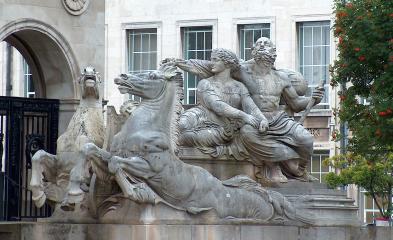
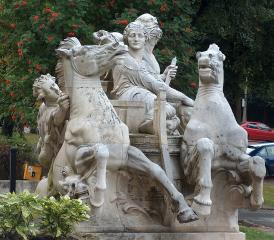
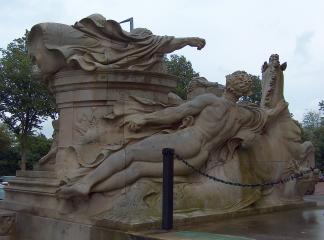
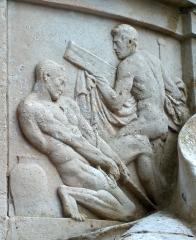
Navigation is a chariot group. Two figures, female and male, ride on a chariot or prow of a small ship pulled by a pair of seahorses, and as with the Mining group, there is a further figure which cannot be seen at the rear, a nude male figure whose arm grasps at the neck of one of the sea-horses, pulled along in their wake as it were. The principle female figure, garbed similarly to those in the Mining group, reclines with her face forward, her arms back and resting on the thigh of her male companion. He reaches one arm behind her neck to guide or point – the fingers are broken – and with the other grasps the rudder to steer their course. He is bare-chested and has one arm bent, and again we have the muscularity beyond that of an athlete. But the strongest impression of this group is the obsessive glare from his upward-turning head, echoed rather by the sea-horses. As with the Mining group there are various low relief details to accentuate the mood of the statues, here including nude male figures hauling and carrying on the side of the chariot.
As said, Albert Hodge is characterised by his muscular figures, and these are typical. There is more work by him on the adjacent Cardiff Town Hall. His female figures – veritable warrior women (see this page) – are generally of this type; his male figures, usually undraped as here, share similar features. There is another older male figure somewhat reminiscent of his Navigator high up on the London Port Authority building in Trinity Square near the Tower of London, and on the same building, a typical younger male on a chariot.
Chariot sculpture in general is uncommon, and Cardiff are lucky to have this group – for more examples, see this page. And for a beautiful water-horse chariot of the late 19th Century, see this page.
A few words on the Glamorgan County Hall itself. It was one of the later buildings on the Cathays Park site, designed and erected in 1909-12, the architects being E. Vincent Harris and Thomas A. Moodie. As well as the sculpture, the frontage towards King Edward’s Avenue features massive coupled Corinthian columns supporting an entablature and balustrade, with side gateways leading to the rear. The sides of the building are plain, but on the rear is carving around the central window by the sculptor A. Broadbent, including cuirasses around a central shield with helm, leafy branches, and relief sculpture of sea-creatures etc in a nod to the Cardiff Town Hall sculpture. Inside is more sculpture, including figures of a druid and a bard by Albert Hodge again; crouched figures favoured by Hodge in other architectural sculpture schemes.
Albert Hodge figures inside the building, and comparable crouched figure statues by Hodge.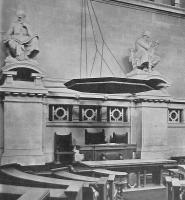
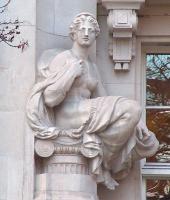
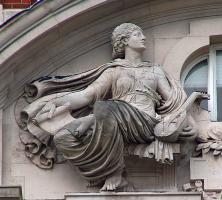
This page was originally part of a 'sculpture of the month' series, for July 2016. Although the older pages in that series have been absorbed within the site, if you would wish to follow the original monthly series, then jump to the next month (August 2016) or the previous month (June 2016). To continue, go to the bottom of each page where a paragraph like this one allows you to continue to follow the monthly links.
Also in Cardiff: the Animal Wall // Cardiff Queen's Building // Boer War Memorial
Sculpture in some towns in England
Visits to this page from 1 July 2016: 5,888